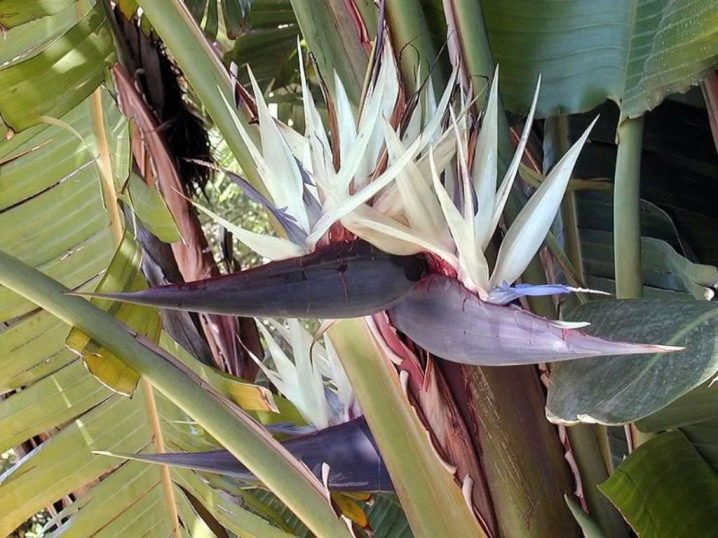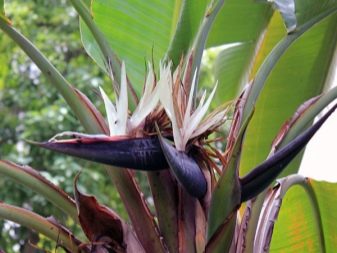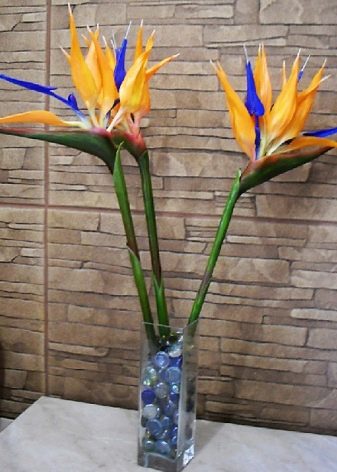What is strelitzia and how to grow a flower?

Among lovers of exotic flowers, such an unusual plant as Strelitzia is becoming increasingly popular. Despite the external showiness, it is undemanding to care for and is available for growing even by novice growers. Therefore, it is worth considering what strelitzia is and how to grow a flower.

Description
Strelitzia - a guest from arid Africa... In natural conditions, it can be both a herbaceous plant and a bush with false stems. One of the species is referred to as trees - a plant with a woody trunk reaches this size, it resembles a palm tree. The height of the exotic "flower" can reach 10 meters, and the width is 4 meters, which is only worth its exotic flowers!
Strelitzia was discovered in the 18th century. The royal flower looks like both the crown and the plumage of a bird of paradise (peacock, hummingbird). The leaves of this species are also unusual - they very much resemble a banana (it is not for nothing that they call it "desert banana" in their homeland). When you look at a flower, it seems that a tiny bright bird has sat down on one of the leaves of a banana tree and is about to fly away.


Strelitzia in science refers to monocotyledonous flowering eukaryotes, ginger flowers. Royal Strelitzia is exactly the original species that was discovered in the Middle Ages. We are now growing it as an indoor flower. In nature, it reaches a much larger size. But at home it does not grow more than half a meter.
The plant not only looks luxuriously royally, but also bears a royal name. The species was named after the Queen of Great Britain, who ruled at that time (late 18th century). Her full name was Charlotte Mecklenburg Strelitzkaya.

The plant has large green leaves with a waxy sheen, arranged in pairs on the same plane. From them, as it were, a fan is formed. The root system is strong and well developed. In nature, the flower grows quickly, in artificial conditions - a little slower and blooms only for 4-5 years of growth.
Strelitzia blooming from spring to late autumn looks very impressive in the interior of the apartment. First, the buds of the inflorescences appear, covered with hard, boat-shaped scales. They are colorful and already very beautiful even before the buds open. Usually they have a hue from black-burgundy to reddish-brown and even red-yellow.

Gradually, the scales open, and one by one unusual buds appear. Each of them has several inflorescences, which are located one after the other, like the crest of an exotic bird. They can be of a variety of colors (depending on the type and variety): yellow, pink, white, blue, purple, and so on. The color combinations and variegated colors are simply amazing.
Flowers appear one by one. Each inflorescence blooms for an average week. Therefore, the period of active flowering is stretched for months in Strelitzia.... You can enjoy a beautiful pet from spring to autumn (it often blooms 2 times a year).

Views
The most famous and cultivated in our country is Strelitzia. royal... It is grown both in pots and outdoors (in areas in the south with a warm climate).

Strelitzia white - a fairly large plant. It occurs naturally in South Africa, reaching a height of 6 meters. The scales in which the flower hides are black, and they release bright white petals. It looks very impressive in contrast. The plant is distinguished by a large number of lignified stems. The flowers do not smell in any way, but at the same time they still attract pollinator insects and small birds, in which they literally shoot their pollen.

Mountain strelitzia - the most rare species. Grows in hard-to-reach places in southern Africa. Vigorous 10-meter tree, large flowers reach more than 50 cm in size.

Strelitzia reed very similar to reed, but is also found in the eastern part of South Africa. It is distinguished by unusually beautiful variegated blue flowers with yellowish and orange hues. The flower is maximally resistant to drought and temperature extremes.

For all the beauty and unusualness of the plant, breeders do not get tired of improving it, experimenting, creating new varieties, such as "Regina" or "august", for example.


In order for a home flower to delight you with its spectacular flowering for a long time, we introduce you to the basic rules of growing. They will become your secrets of success in keeping this beautiful and unpretentious plant.
Landing
A sufficiently large and deep pot is chosen for planting, since the flower grows powerful and long roots. In this case, you should not immediately take too large a pot - otherwise the plant will not please you with its flowering for a long time. Young shoots are transplanted every spring. When the strelitzia is 4-5 years old, transplants are carried out no more than once every 3 years.
The soil is selected nutritious, but at the same time neutral. Ready-made soil for flowering houseplants can be used. The earth is preferable light. You can cook it yourself by mixing 1 part of sand, part of forest land, 2 parts of peat and humus.
It is important to provide high-quality drainage to a plant that simply does not tolerate excess moisture. Its roots can rot, and Strelitzia can die. For this, small expanded clay and medium-sized granules are mixed in equal parts, lining the bottom to a height of about 2-3 cm. Then the pot is already filled with a nutrient mixture. Instead of expanded clay, you can also use special drainage compounds, such as perlite, and others that can absorb excess moisture.

When transplanting a young plant, a pot size is chosen annually. Accordingly, the drainage layer is also increased, since the root system of the flower is rapidly developing and growing deeper. They line the bottom with a layer of expanded clay with new earth, and also complement the sides around the old clod of strelitzia earth.
When transplanting, pay attention to the roots: if there are rotten areas, damage, then you need to remove them and sprinkle with crushed coal (treatment with ordinary activated pharmaceutical carbon is also good) so that the underground parts do not get sick. After that, the plant can be transplanted into a new container.
Be careful! Strelitzia roots are quite fragile and easily damaged. Therefore, it is better to transplant this species by the transshipment method, and when filling the free space in the pot with earth, do not greatly soften and do not press on the soil when compaction, so as not to break the roots. After that, the plant is sick for a long time and may not produce flowers.

Care
It is not at all difficult to grow a spectacular exotic at home. But if you want to see at home many beautiful bright flowers of an unusual appearance and shape, you should know some simple rules and tricks of this generally undemanding plant to care for.
A place
Strelitzia requires a lot of sunlight, but at the same time it reacts poorly to direct sunlight... If possible, place the planter on the east side window. If it is south or southeast, the container with the plant at lunchtime needs to be shaded or moved from the window so that the leaves do not burn out.
The flower loves fresh air, but does not like drafts. In warm weather, it is recommended to take it out into the street, on the balcony, observing the above rules with the illumination mode.
In winter, you can create additional light sources using LED lamps or special plant lights.

Temperature regime
A comfortable room temperature can be maintained in a plant room all year round. It feels good at plus 22-25 degrees.
In winter, it is impossible for the temperature to drop below +12 degrees.


Watering
The plant needs regular, but moderate watering with settled soft water at room temperature... Prepare it in advance. Water the flower about 2 times a week. It is necessary to focus on the drying of the earthen coma in a container with a plant. If the ground is dry to about a third of the depth, only in this case the flower is watered.
The plant perceives an excess of moisture much worse than a lack. Therefore, the drainage must be of very high quality so that the water does not stagnate in the roots, but is drained into the pan... For adult plants of about the third year of life with a formed root system, you can use a pots with automatic watering. This will save you the hassle and provide the flower with an even flow of moisture in the right amount for it, enough and regularly.
In winter, especially during the dormant period, the plant is watered very sparingly and rarely, reducing both the volume of water and the number of irrigations to once every 7-12 days. Growing strelitzia in artificial conditions has its own nuances. So, the flower loves moist air, so it needs to be regularly sprayed with a spray bottle. This is especially required in the heat or in winter with dry air from heating devices. In the cold season, you can simply wipe the strelitzia sheets once a week. In the phase of active growth, it is advisable to install humidifiers or a pallet with wet expanded clay in the room.

Top dressing
The plant needs regular balanced feeding during the period of active growth and flowering from March to late autumn. You can use ready-made formulations for flowering houseplants from the store.
In order for the plant to bloom, after a dormant period, they begin to water it once every 10 days using fertilizer... In this case, organic substances and mineral compositions alternate every other time. So the flower will receive all the nutrients necessary for its growth, health and flowering.
In winter, feeding is completely stopped for 2-3 months.

Rest time
To see the impressive strelitzia bloom, recommend annually to arrange a rest period for an exotic handsome man. At this time, the plant is placed in a less illuminated place with a moderately cool temperature: plus 12-16 degrees (not lower). Stop feeding and give the flower a moderate amount of moisture.
After that, with the onset of spring, the strelitzia is placed in a sunny place in the usual comfortable conditions and begins to actively feed it according to the scheme described above.
To make strelitzia bloom, it is enough to properly care for it and follow all the rules during the rest period. Then the flowers will definitely appear.

Reproduction
Strelitzia royal and its other species reproduce in two ways.
Seeds
In natural conditions, the flower is pollinated by insects and tiny birds, sunbirds. When keeping a house, you can help the flower and pollinate it with a soft brush, transferring pollen from one plant to another (this will require 3-4 plants). Six months later, hard boxes, similar to dark nuts, ripen on it. They are carefully cleaned and planted in nutritious moist soil, buried to a depth of 3 centimeters. Set up a mini greenhouse by covering the pot or container on top. Every day, the "greenhouse" is ventilated and moistened by the earth. A sufficiently warm temperature for germination is required, plus 25-26 degrees.
After 2-3 months, the seeds germinate, and they can each be planted in their own separate small pot.

By dividing the bush
The plant gives good lateral shoots, which can be separated from the mother flower during transplantation in the spring. It is important to do this very carefully, without damaging the roots, which are often intertwined with each other.

Diseases and pests
If you follow all the rules for caring for Strelitzia, she is not threatened with illness.
- But it happens that the leaves curl. Most likely, this is an indicator that a tick or shitnikov attacked the strelitzia. Examine and rinse the leaves very carefully. Then you need to treat the whole plant with high-quality insecticides. Treatment, if necessary, can be repeated several times at intervals of 5-7 days.
- If the leaves are covered with black spots, this indicates excess moisture.
- Dry tips and yellowing of the edges suggests that the leaves were burned by excess sunlight.
- Falling flowers speaks of root disease, their possible decay. This is also observed with rare feeding, lack of nutrients.
In general, strelitzia is an unpretentious plant and rarely gets sick, if you follow simple rules for care. Then the exotic guest will regularly delight you with his royal flowers.








































































































The comment was sent successfully.